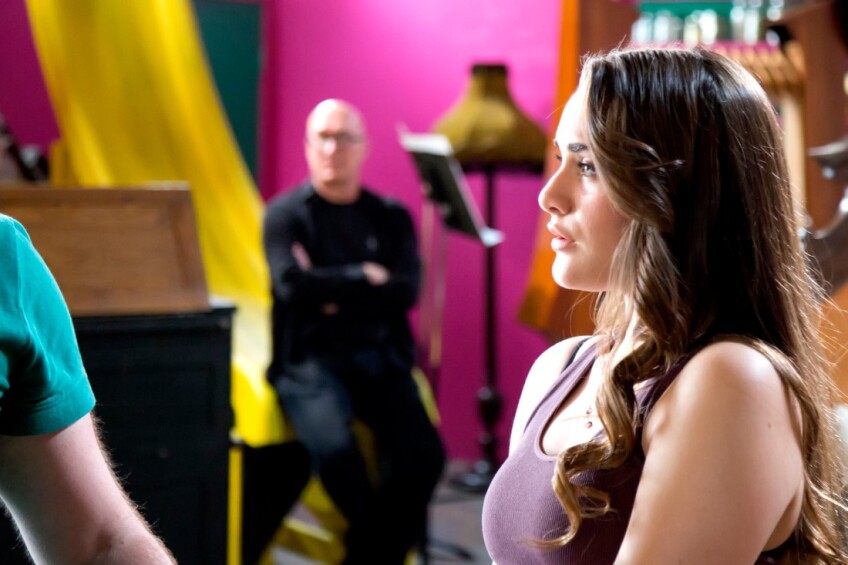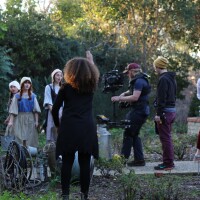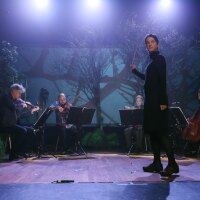Rowen Sabala Navigates Teen Years and Opera Stardom

Vireo, the groundbreaking made-for-TV opera, is now available for streaming. Watch the 12 full episodes and dive into the world of Vireo through librettos, essays and production notes. Find more bonus content on KCET.org and LinkTV.org.
Soprano Rowen Sabala is in her first semester at Drake University in Des Moines, Iowa, but she’s already starred in a world premiere opera – at the ripe old age of 17. That work, “Vireo: The Spiritual Biography of a Witch’s Accuser,” is also a first. A made-for-TV-and-online opera composed by Lisa Bielawa with a libretto by Erik Ehn and directed by Charles Otte, the serial opus that follows the labyrinthine adventures of the titular character who hears and sees things - and is ultimately accused of being a witch - premieres in June and has already received the 2015 ASCAP Foundation Deems Taylor/Virgil Thomson Multimedia Award.

Having recently turned 19, Sabala, who is in each of the 12 episodes of the work that was filmed in various locations in Southern California, New York, and San Francisco – including Alcatraz - shows no signs of being, or becoming, for that matter, a diva. Indeed, the Orange County-born teenager, who has been singing since she was a toddler in church choirs and performed as a supporting player in a number of musicals such as “Cats,” “Peter Pan” and “The Sound of Music,” is taking success in stride.
“I had a fair amount of lines and songs to sing and stuff,” explained Sabala, “but I stopped doing musicals in the ninth grade. “Vireo” was the first role I’d had in a few years and I wasn’t even planning to audition, but people were pushing me.”
The year was 2014 and Sabala, who was then attending Orange County School of the Arts (OCSA), said she knew very little about the project that was being co-produced by John Spiak, director and chief curator of Cal State Fullerton's Grand Central Art Center.
“Between 20 and 30 girls auditioned,” Sabala recalled, “and there were five girls chosen for the callback [where] we did more acting and worked one-on-one with Lisa from the ‘Vireo’ excerpts that we sang. After we finished, they told us they would email us. According to Lisa [Bielawa], she told me that on their way to the car they already knew, and I got an email probably a half hour later.”
Even for experienced singers, learning a new role by a living composer is notoriously difficult, but for a novice, the task would seem even more daunting. Sabala, who admits to not listening to much classical music and cites the late singer Amy Winehouse as an influence (“She’s someone I could listen to her music nonstop - and I do.”), said that she initially spent a lot of time working with Bielawa.

“I wasn’t used to that kind of music and Lisa wasn’t sure what she wanted and how it would sound. It took a lot of rehearsing with her, as well as my accompanist, Gabriel Lawson. The first episode took about three months of rehearsals, but the third and fourth took less time, and after that, I was able to learn it on my own.
“Lisa would send out a recording of the piece,” added Sabala, “an instrumental track pulled from the computer, and she would sing our voice parts and we could figure it out from there. I got to a point [that] if I needed anything I could plunk it out on the piano. I’m not proficient on the piano, but I can play and I can sight-read.”
With a total run time of nearly three hours - if you binge-watched all 12 of the ten 12-minute episodes in one sitting - “Vireo” is about the same length as an average opera. But the similarities, for the most part, end there. Featuring a number of stellar musicians, including the Kronos Quartet, the American Contemporary Music Ensemble, the Bay Area choral group Cappella SF, and even a high school marching band, the work also unfolds in multiple time periods simultaneously: The character Vireo exists in modern day Sweden, 16th-century France and Vienna near the turn of the 19th century.
With so much on her operatic plate, one wonders how Sabala was able to fully inhabit such a complex character - musically, physically and psychologically, not to mention that the portrayal demanded fierce acting chops. After all, Vireo not only has seizures in which she shouts and twitches uncontrollably, sees a witch being condemned to death and is treated for “hysteria,” but she’s also drugged with morphine and is arrested for perjury, after which she is sent to the infamous prison, Alcatraz.
“I took some acting classes and the theater stuff helped me as well, but I was used to being comical characters - the very uppity and funny, sometimes ditsy ones. Vireo was very different, but to me it wasn’t like putting on a fake face.
“You can feel Vireo’s pain,” continued Sabala. “She became a part of me, and I felt like the way she thought, and felt I kind of came up with that as we learned more about Vireo. Charlie [Otte] also helped, the director. He would work with me a lot [giving] me analogies to help me think of things better, and push me a little bit to help me really see who Vireo was. He was very good about making sure that I decided how she was, but he would give me ideas and we would bounce back on each other.”
As for being drugged (in episode ten), however, Sabala said that was completely foreign to her.
“I’ve never been on morphine – that was strange for me - but the entire opera is kind of a drug trip, so that one was just a matter of noticing what was around me. I was laying on a gurney – I do nothing else - while they sing around me in a circle and I kind of stare at the ceiling blank, transfixed. Charlie [Otte] would give me ideas and rough sketches of how one might see or feel at that time – or if they can see or feel.”
Sabala did her fair share of research as well. Though she had never been to Europe, she pointed out that she did have some background knowledge about the Salem witch trials. “I also would do a little research on schizophrenia, and it was something you kind of figured out as you went.”
In addition to vocal and acting challenges, the long shoot days and change of venues also proved somewhat troublesome, not the least of which was performing in an abandoned medical wing on Alcatraz for the ninth episode.
“We had three hours to film there and it was very challenging to adjust to the sound of different places, because they all sound so incredibly different. With Alcatraz, it’s all cement, so everything rings and bounces off the walls, and we were also in different rooms. I would have to watch Lisa from the hallway and I couldn’t see the string quartet that we were working with, and I barely heard them.
“I had to follow Lisa around – just with my eyes – because the camera was on me and I had to make it look subtle.”
Episodes three and four were filmed in L.A. at the Actors’ Gang Theater, also in different rooms, with three different conductors “going at once,” explained Sabala. “That’s difficult to not be able to move with the musicians, because you can’t hear them. I’m used to audible musical cues – that’s how I know when to come in - and I’m very independent about my singing.
“I tried very hard not to follow anyone,” added Sabala, “so Lisa always made me turn away from her. But if I needed her, she was right where I could see her. It’s difficult working in places like that when there was no way to see everyone.”
What wasn’t difficult was working with such superb musicians as the Kronos Quartet, the group featured in the first two episodes and the final segment of “Vireo.”
“I’d never actually heard of Kronos Quartet before ‘Vireo,’ and I got to know them without knowing them as a famous group,” Sabala enthused. “We all became buddies and I really appreciated how serious they were when it came to the music itself, because I, myself, am like that. It was very easy for us to work together in that we had similar ideas about music.
“They were also open to changes,” noted Sabala, “and would adapt to whatever was needed at that time. It was really great working with them and I hope to work with them in the future.”
Ultimately, working on “Vireo” was a learning experience for the promising young soprano, who said she discovered myriad things about herself, music and the art of collaborating.
“I knew how to, of course, before, but this was an entirely different kind of collaboration, and it was different every time. It was like learning new dialects between everyone. We all spoke the same language, but it was all slightly different in some way. Learning how to adjust to those changes – with the people and the music itself – was something I took away from ‘Vireo.’”
“Also, I became a lot more independent and confident – not in singing, but with the music in general. I learned a lot more about what goes into the music and the process of it all. Instead of me learning the songs by myself and meeting with an orchestra once who already knows it and we sing together and it’s done, it was more like I was learning it and they were learning it at the same time.
“And when we saw each other,” added Sabala, “it was nice not to be so cut and dry about it. I learned a lot about people in general, and my relationships with people.”
Top Image: Remsen Allard


